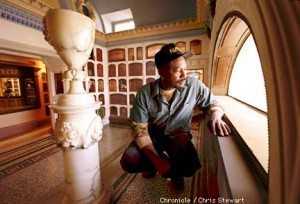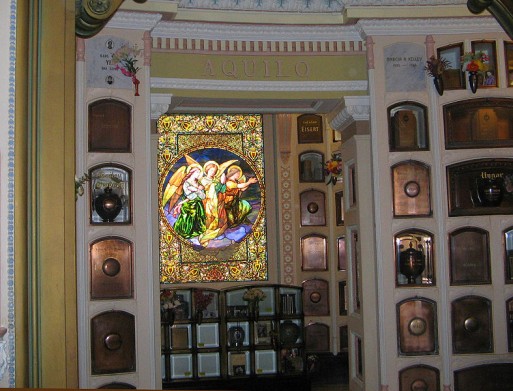Emmitt Watson has been the caretaker of the Neptune Society’s San Francisco Columbarium for over 25 years, and has gathered the stories to match the years. He has seen this unique and historic landmark through a dramatic renovation, from a crumbling relic of a bygone era into the famed destination, cultural icon and center of life in the city’s Noe Hill neighborhood that it is today.
Antal: First off, could you tell us a little about the history of this place? What is a columbarium?
Emmitt: Sure thing. This particular columbarium comes from the Greek and Roman times. They used to be domestic kitchens, places where work was done, where communities gathered. The San Francisco Columbarium was founded in 1898 by a fraternal group from England called the Oddfellows. They commissioned the architect Bernard J. Cahill to build the place. This was before cremations were even very common. Originally this area was a 175-acre cemetery, past Divisadero Street, which used to mark the city limits. In 1901 the city started making the first laws regulating the death industry in San Francisco. In 1910 they outlawed cremations, and the crematorium was demolished. In 1919 they outlawed any burials within the city limits, so people started taking their loved ones to the town of Colma, to the South. They started pulling the cemetery up in the early ‘30s, and intended to tear the Columbarium down as well, but in 1934 the Homestead Act came into effect and protected it. The place was abandoned at that point, and left to the ravages of time for almost 45 years.
Antal: How was the building rediscovered?
Emmitt: In the late ‘70’s the Neptune Society, which was only just getting to be a force, headed by R. J. Garden, purchased it. They started the renovation process. Now it’s a landmark, an important part of the city. Carlos Santana’s mother, Harvey Milk, and a lot of the people who built up San Francisco, the Haights, the Folgers, the old pioneers, all of them have their ashes here.
Antal: What was it like before the improvements?
Emmitt: They started the renovation in 1979. I came on in 1987. I saw most of the process. You know, they had mildew, cobwebs. The stained glass windows were cracked, dirty. There was water in the walls and it smelled damp. Homeless people used to camp here before the Neptune Society purchased it, and you could still tell. There’s still water in the walls today, there’s still a lot of work to be done, all the time, and I’m the only one that does it. People think that there’s a whole crew of people working on this, but no, it’s just me.
Antal: To give our readers an idea of what this place is, could you describe what they would see when they walk through the front doors?
Emmitt: Well, this place is circular, and the main floor rotunda is supported by eight columns which climb the length to the ceiling, basically steel beams encased in cement. There are five niches, places for storing urns and cremation remains, in each section of these columns, but most of the niches are in the rooms between the columns. You walk through the front doors and immediately you just see the colors, see how alive the place feels. Each niche has its own personality. There are stained glass windows. People are usually so busy looking at the colors they forget the urns, they don’t see them, they see everyday items from people’s lives. One man liked to drink martinis, so his family brought his favorite martini shaker to put his ashes in. One man was a baseball fan his whole life, and his ashes are in a ceramic baseball, and the niche is decorated to look like a baseball stadium. See, that’s part of a person’s life, and his death. It’s a sort of living monument, as opposed to a tombstone, which is just about death, nothing about life. A lot of people come in here and they don’t even see the death. They don’t even realize that there are people’s ashes buried here. This place disguises death with all this life. That’s not what most people think when they think about cremation, but that’s what this columbarium is.
Antal: What kind of ceremonies do people perform?
Emmitt: Well, for example just this morning I asked a family who was having a service if they wanted to put their loved ones’ urns in themselves. They chose to do that, and I just left them to have their privacy. Sometimes they have services with family, with friends. Sometimes the family doesn’t even want to be here, and they get us to set up the niche ourselves. They can come and visit later. Then there’s also those who have full on memorial services, with glass tables and a minister to bless the urn, a celebration with drinks and catered food. Really people do whatever they want. That’s up to them. Everyone has to take this event in their own way, and we have to respect that.
Antal: How many services are performed here?
Emmitt: Sometimes we do three to four a week, sometimes we won’t have one for a month. Today there’s a celebration service, but no ashes. The family chose to have the service here but may not have ashes interred today. Otherwise, this building is used for all kinds of things. We have weddings here, parties, events. The place is so well known now. And me too, a lot of people come to this columbarium just to hear my stories. ‘Cause I got a lot of them.
Antal: Do you have any advice for readers preparing for a death?
Emmitt: Well, most people are scared of death. My advice is to learn about it, to see it as something that’s not to be scared of. To handle it, you need to know about it earlier, before it happens, so when it finally comes you’re prepared.
Antal: Thanks so much for speaking with us.
Emmitt: Absolutely, my pleasure.
While the San Francisco Columbarium has no official website, you can read more about it on Noe Hill’s landmarks page, and choose from a wealth of newspaper and online posts devoted to the history of this wondrous building, and the people who have kept it alive. Over the years it has become a unique and beautiful destination in its own right.
Read related posts on SevenPonds:
- SevenPonds Helps You Shop Funeral Services: Four Tips to Guide Your Decisiosn When Selecting Cremation Services
- Memorial Jewelry Helps You Stay Connected While You Grieve: Designer Scosha Woolridge Adds this Touching Custom Piece to Her Collection
- Japan’s Hotel for the Dead: Lastel Addresses Overcrowding in Crematoriums and Offers Families a Place to Pay Their Respects

 What is a columbarium? An Interview with Emmitt Watson
What is a columbarium? An Interview with Emmitt Watson




 First the Wealth Gap, Now the U.S. Has a Growing Health Gap
First the Wealth Gap, Now the U.S. Has a Growing Health Gap

 Our Annual Seven Holiday Gifts for Someone Who Is Grieving, 2024 Edition
Our Annual Seven Holiday Gifts for Someone Who Is Grieving, 2024 Edition














